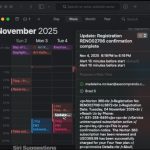Folks here have broken the bypass tray on my workhorse Brother HL-L8350CDW, so when I happened across our electronics recycling bin at work and noticed a HL-L3250CDW, I quickly snatched it. It needed toner and new drums, no biggie. I picked up some of these off of eBay and have it operating; however, the magenta toner is shifted a bit. I’ve been messing around with the printer’s maintenance mode to make manual tweaks. To access this menu:
- On top of the printer, hold the home button for 5 seconds.
- Next four white boxes appear on the display, press and hold on the bottom box for 3 seconds then release.
- Using printer’s on-screen keypad, type *2864 and it will say “MAINTENANCE” across the top of the screen.
- Using printer’s on-screen keypad, type *66 and it will say “REGISTRATION” across the top.
- Using printer’s on-screen keypad, tap the “>>” button twice and you’ll reach a keyboard with arrow buttons.
- Tap the up arrow twice to navigate to “PRINT CHART”, then press “SET”.
This post may be a work in progress as I next explain how to improve the alignment of what you see from the printed output. This is an iterative process that is necessary, because the third party toner cartridges must not be fully compatible with Brother’s firmware.



